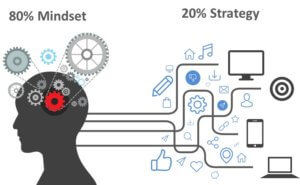I’ve no doubt you’ve heard Benjamin Franklin’s quote, ‘If you fail to plan, you are planning to fail’.
Maybe it was said to you as you prepared for an important presentation or project at work.
Maybe you’ve imparted this wisdom to a recruit or colleague.
Or maybe you’ve read the statement and thought, ‘Yes, that’s obvious, it makes sense’, and left it at that.
Mindset Vs. Strategy
You see, success is 80% mindset & 20% strategy. And if you follow my work, you’ll know I’m all about the mindset!
Yes, programming a winning mindset will get you far. It will power you to get back up after you’ve fallen, give you that determination to succeed, and help build your resilience to keep going when it gets tough.
But let’s not underestimate strategy and planning. (Check out A Strategic Plan – what to include in yours)
Having a strategy is about making sure you are in the driver’s seat with a clear vision of where you want to get to, why you want to go there, and how you’re going to turn your vision into reality, a.k.a your plan.
Planning will ease the bumps in the road, allow you to consider your choice points when they arise and force you to sit down and think about your future growth – of your business, your people and you.
Put simply, you’re giving the 20% strategy a fighting chance to succeed.
Why failing to plan really does mean planning to fail
Key lessons to learn from the race to the South Pole
A fascinating story which brings this point to life is the race to the South Pole in 1911 between the successful expedition led by Norwegian explorer Roald Amundsen and the failed one led by Robert Falcon Scott.
On paper, it was a perfectly matched competition. Amundsen and Scott were similar ages, and each could boast plenty of experience in daring polar exploration. They set off within days of each other, and it was reasonable to assume they might arrive simultaneously; such was their mutual reputation. But that’s not what happened at all.
Before I continue, let’s consider some of their hardships: gale-force winds, temperatures of -20F, even during the warmest months, and a round-trip journey of more than 1,400 miles. That would be a severe challenge today, even with all our modern equipment and expertise; it’s hard to comprehend how much harder it was in 1911.
Amundsen had been preparing for years, however. He adopted an intensive and long-term fitness regimen. When he travelled more than 2,000 miles from Norway to Spain to earn a master’s certificate in sailing, he didn’t go by ship or train but by bicycle. He planned for scenarios he might only face once in a lifetime, such as testing the usefulness of raw dolphin as a source of nutrition. He studied the Inuit people in northern Canada and discovered how it was better to move slowly in cold conditions so sweat couldn’t form and turn to ice. He was 39 when he set off on his journey to the South Pole, but he had already been on a quest for personal mastery from a tender age.
Scott’s preparation paled in comparison, and significant differences in their planning emerged
1.) Amundsen learned that dogs thrive in Antarctic conditions and spent time with the Inuit people in the north of Canada to learn to dogsled. Scott selected a mixture of ponies entirely unsuited to Antarctic conditions and motor sledges, which were brand new, untested, and quickly failed. The result: while the Amundsen party ran their teams of dogs to the pole and back, the men on Scott’s team had to pull their sledges themselves, moving far more slowly and exhausting themselves along the way.
2.) Amundsen laid down supply caches along the route and marked them with black flags to be visible for miles on their way back. Scott did not.
3.) Amundsen stored three tons of supplies for five men starting. Scott stored one ton for 17 men.
4.) Amundsen carried enough extra supplies that he would be able to miss every one of his stock supplies and still complete the journey. It would be the end for him and his team if Scott missed even one of his stock supplies.
5.) Amundsen brought four thermometers. Scott brought one, which broke.
6.) While both men knew there was no way to remove all the risks, Amundsen prepared for the worst weather, unexpected geographical challenges and other hurdles. In contrast, Scott appears to have operated, hoping everything would work out. In his journal, discovered with his frozen body years later, Scott complained about his bad luck.
On 15 December 1911, Amundsen and his team planted the Norwegian flag in the South Pole. It would probably have stunned him to know that the Scott expedition was still 360 miles from the pole, man-hauling their sledges and would take another 34 days to get there. By the time they did, the Amundsen team was just eight days from their home base. They reached it precisely on the day they planned.
Amundsen was already sailing back to Norway when Scott’s team finally gave up hope, exhausted, depressed, frostbitten, and near starvation. Their frozen bodies were discovered in a tent eight months later. It’s a tragic tale for those brave men but also a cautionary tale. If Amundsen had reviewed Scott’s plans before setting out, he would probably have urged him not to go.
Six fundamentals of planning
In this story, the fundamentals of planning are brought home;
#1 Scott set himself up for failure. Amundsen set himself up for success.
#2 Amundsen’s planning was future-proofed through ‘what if’ scenarios with plans B, C, and D (remember the saying there are 25 other letters in the alphabet if plan A fails).
#3 Improvement, growth and success need direction and a sense of purpose. They won’t happen on their own.
#4 A clear roadmap forces accountability and responsibility, which sometimes may lead to a change in route. This is OK. Accept this and follow your new path.
#5 Risks can be turned into opportunities, but you need to have identified them as risks first; otherwise, they’ll come at you as a crisis, and then you’re on the back foot.
#6 The ‘weight’ of a decision is reduced when you’ve had time to consider and calculate its upside and downside.
#7 For Scott and Amundsen, their results were aligned directly to the quality of their planning.
While I’m not suggesting you trek to the South Pole to test your planning abilities (!), look at your current priorities, projects, goals, targets and ambitions and ask…
Do I have a plan?
Do I have clear goals with critical milestones and actions?
Have I identified the risks and put actions in place to mitigate them?
Do I understand the decisions that need to be made & the choice points I have?
Do I know the stakeholders who can help me with those decisions?
Am I operating in the Scott or Amundsen planning camp?
Am I failing to plan or planning to fail?


